Case Study Analysis: Unsatisfactory Professional Conduct in Healthcare
VerifiedAdded on 2020/01/21
|7
|1751
|63
Case Study
AI Summary
This case study analyzes a situation involving a nurse's unsatisfactory professional conduct, detailing instances where the nurse failed to meet professional standards of care. The report examines the specific actions that constituted misconduct, including inadequate documentation, failure to notify a physician of a patient's deteriorating condition, and a general lack of adherence to the standards set by the NMBA. The study highlights the importance of professional behavior, providing information, recording details, and adhering to ethical guidelines. It explores what the nurse should have done, the need for collaboration within the healthcare team, and the potential mitigating factors. The document emphasizes key takeaways, such as the importance of teamwork, communication, and adherence to ethical codes to ensure quality patient care. The analysis also references relevant literature and professional standards to support the findings and recommendations.
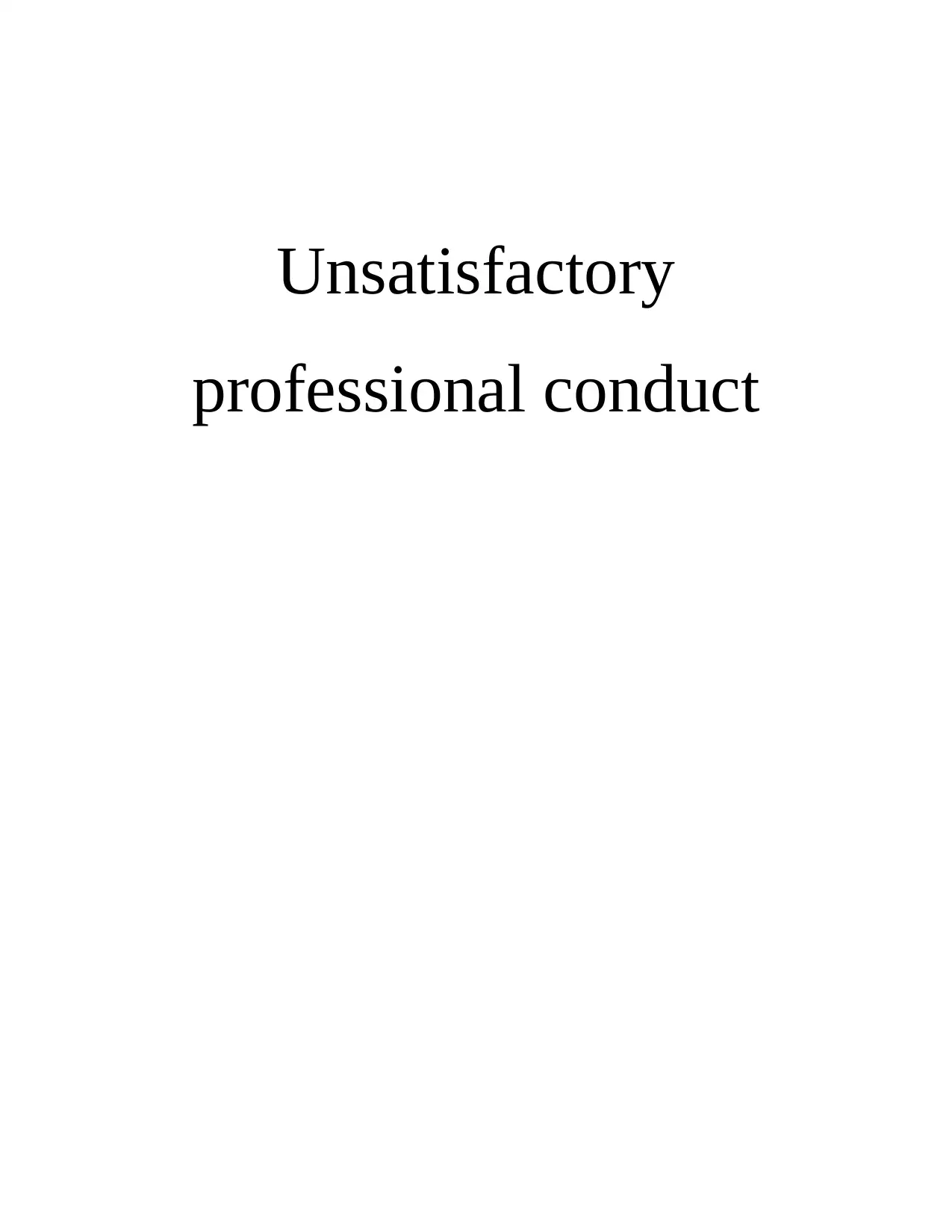
Unsatisfactory
professional conduct
professional conduct
Paraphrase This Document
Need a fresh take? Get an instant paraphrase of this document with our AI Paraphraser
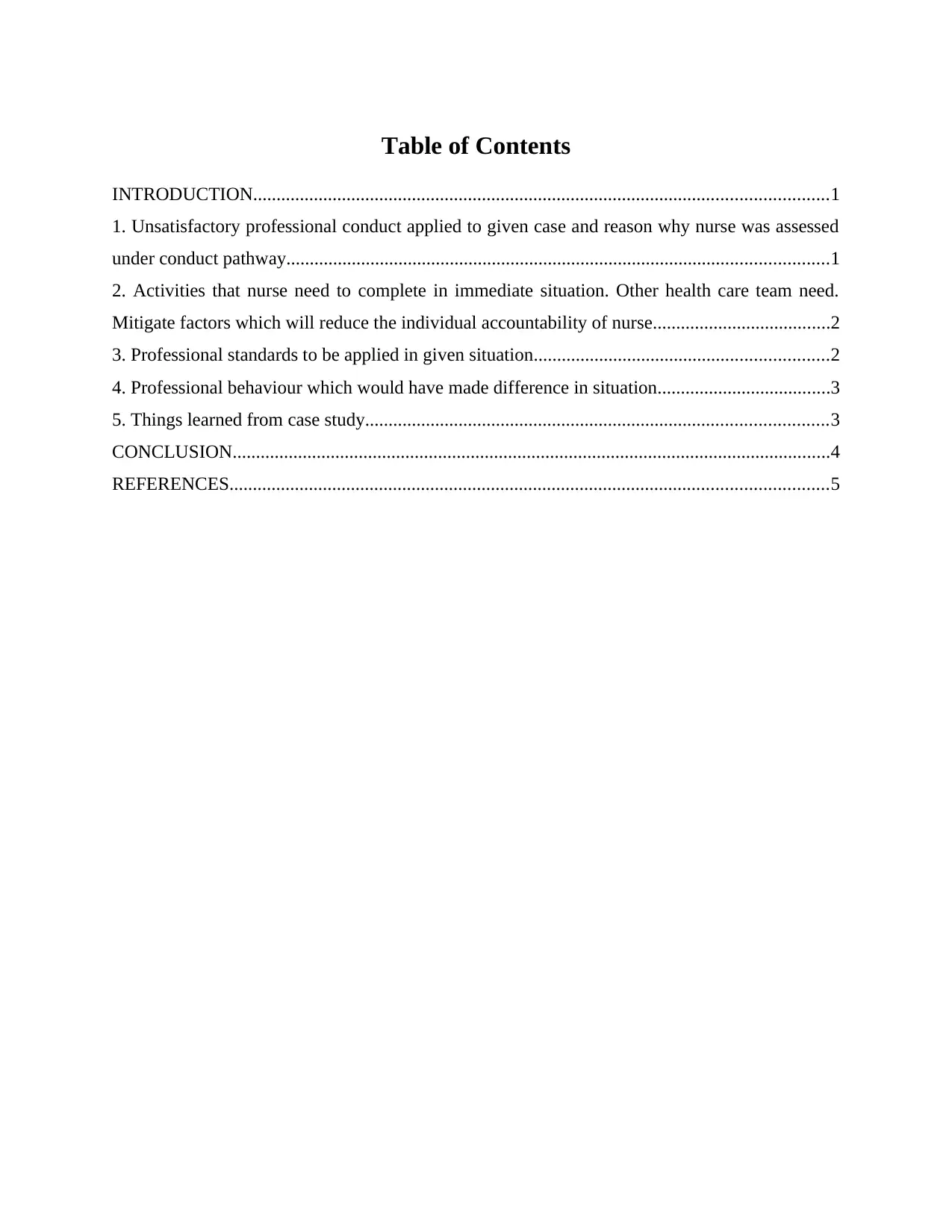
Table of Contents
INTRODUCTION...........................................................................................................................1
1. Unsatisfactory professional conduct applied to given case and reason why nurse was assessed
under conduct pathway....................................................................................................................1
2. Activities that nurse need to complete in immediate situation. Other health care team need.
Mitigate factors which will reduce the individual accountability of nurse......................................2
3. Professional standards to be applied in given situation...............................................................2
4. Professional behaviour which would have made difference in situation.....................................3
5. Things learned from case study...................................................................................................3
CONCLUSION................................................................................................................................4
REFERENCES................................................................................................................................5
INTRODUCTION...........................................................................................................................1
1. Unsatisfactory professional conduct applied to given case and reason why nurse was assessed
under conduct pathway....................................................................................................................1
2. Activities that nurse need to complete in immediate situation. Other health care team need.
Mitigate factors which will reduce the individual accountability of nurse......................................2
3. Professional standards to be applied in given situation...............................................................2
4. Professional behaviour which would have made difference in situation.....................................3
5. Things learned from case study...................................................................................................3
CONCLUSION................................................................................................................................4
REFERENCES................................................................................................................................5
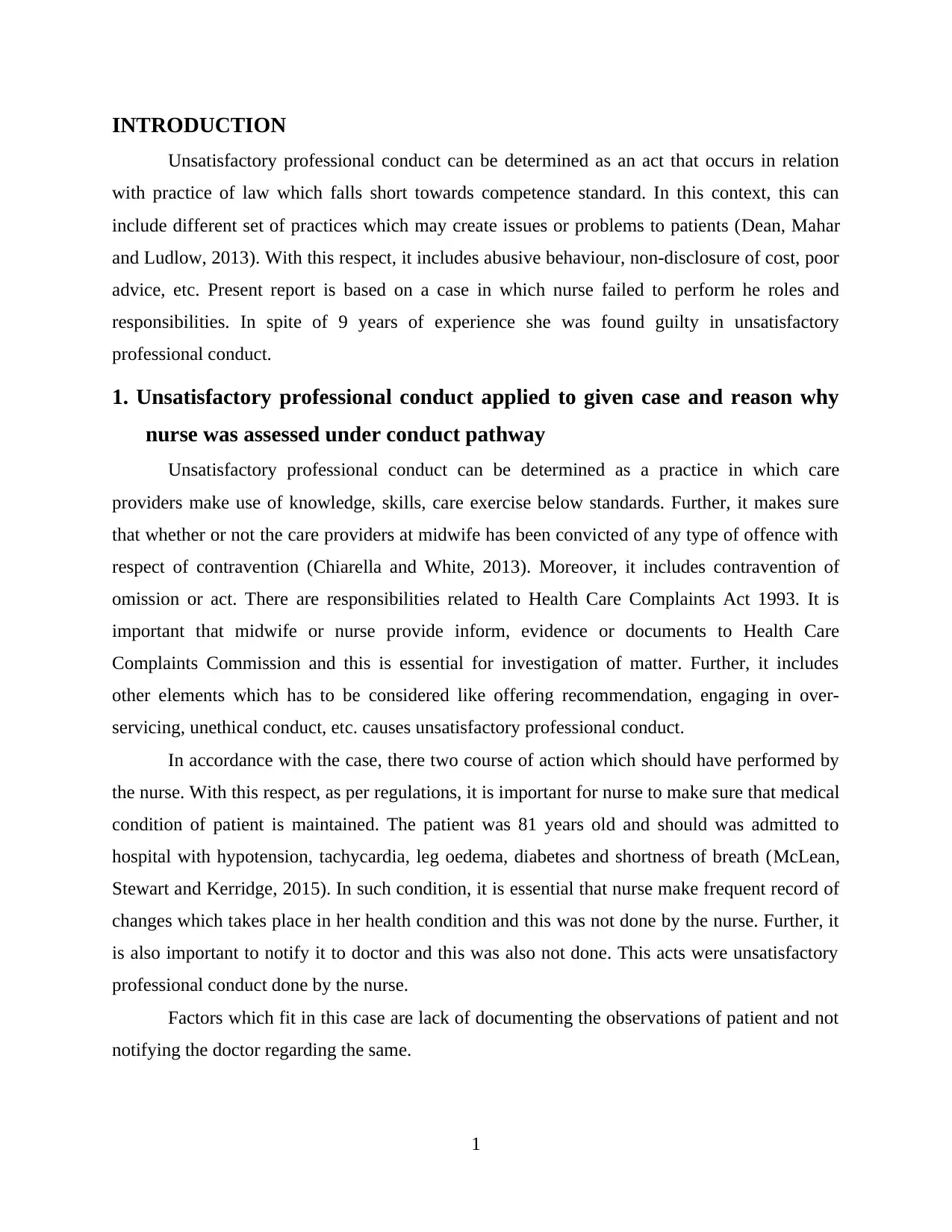
INTRODUCTION
Unsatisfactory professional conduct can be determined as an act that occurs in relation
with practice of law which falls short towards competence standard. In this context, this can
include different set of practices which may create issues or problems to patients (Dean, Mahar
and Ludlow, 2013). With this respect, it includes abusive behaviour, non-disclosure of cost, poor
advice, etc. Present report is based on a case in which nurse failed to perform he roles and
responsibilities. In spite of 9 years of experience she was found guilty in unsatisfactory
professional conduct.
1. Unsatisfactory professional conduct applied to given case and reason why
nurse was assessed under conduct pathway
Unsatisfactory professional conduct can be determined as a practice in which care
providers make use of knowledge, skills, care exercise below standards. Further, it makes sure
that whether or not the care providers at midwife has been convicted of any type of offence with
respect of contravention (Chiarella and White, 2013). Moreover, it includes contravention of
omission or act. There are responsibilities related to Health Care Complaints Act 1993. It is
important that midwife or nurse provide inform, evidence or documents to Health Care
Complaints Commission and this is essential for investigation of matter. Further, it includes
other elements which has to be considered like offering recommendation, engaging in over-
servicing, unethical conduct, etc. causes unsatisfactory professional conduct.
In accordance with the case, there two course of action which should have performed by
the nurse. With this respect, as per regulations, it is important for nurse to make sure that medical
condition of patient is maintained. The patient was 81 years old and should was admitted to
hospital with hypotension, tachycardia, leg oedema, diabetes and shortness of breath (McLean,
Stewart and Kerridge, 2015). In such condition, it is essential that nurse make frequent record of
changes which takes place in her health condition and this was not done by the nurse. Further, it
is also important to notify it to doctor and this was also not done. This acts were unsatisfactory
professional conduct done by the nurse.
Factors which fit in this case are lack of documenting the observations of patient and not
notifying the doctor regarding the same.
1
Unsatisfactory professional conduct can be determined as an act that occurs in relation
with practice of law which falls short towards competence standard. In this context, this can
include different set of practices which may create issues or problems to patients (Dean, Mahar
and Ludlow, 2013). With this respect, it includes abusive behaviour, non-disclosure of cost, poor
advice, etc. Present report is based on a case in which nurse failed to perform he roles and
responsibilities. In spite of 9 years of experience she was found guilty in unsatisfactory
professional conduct.
1. Unsatisfactory professional conduct applied to given case and reason why
nurse was assessed under conduct pathway
Unsatisfactory professional conduct can be determined as a practice in which care
providers make use of knowledge, skills, care exercise below standards. Further, it makes sure
that whether or not the care providers at midwife has been convicted of any type of offence with
respect of contravention (Chiarella and White, 2013). Moreover, it includes contravention of
omission or act. There are responsibilities related to Health Care Complaints Act 1993. It is
important that midwife or nurse provide inform, evidence or documents to Health Care
Complaints Commission and this is essential for investigation of matter. Further, it includes
other elements which has to be considered like offering recommendation, engaging in over-
servicing, unethical conduct, etc. causes unsatisfactory professional conduct.
In accordance with the case, there two course of action which should have performed by
the nurse. With this respect, as per regulations, it is important for nurse to make sure that medical
condition of patient is maintained. The patient was 81 years old and should was admitted to
hospital with hypotension, tachycardia, leg oedema, diabetes and shortness of breath (McLean,
Stewart and Kerridge, 2015). In such condition, it is essential that nurse make frequent record of
changes which takes place in her health condition and this was not done by the nurse. Further, it
is also important to notify it to doctor and this was also not done. This acts were unsatisfactory
professional conduct done by the nurse.
Factors which fit in this case are lack of documenting the observations of patient and not
notifying the doctor regarding the same.
1
⊘ This is a preview!⊘
Do you want full access?
Subscribe today to unlock all pages.

Trusted by 1+ million students worldwide
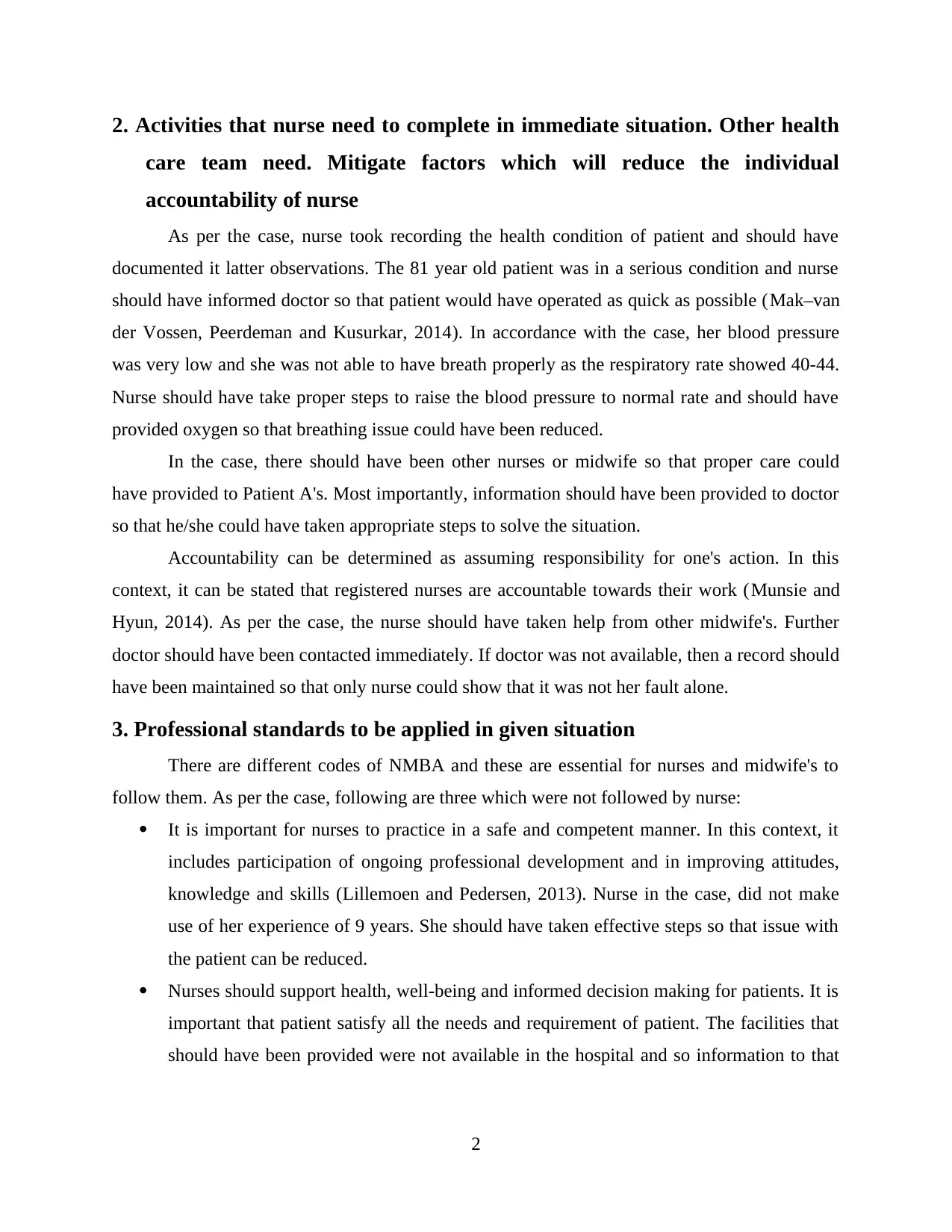
2. Activities that nurse need to complete in immediate situation. Other health
care team need. Mitigate factors which will reduce the individual
accountability of nurse
As per the case, nurse took recording the health condition of patient and should have
documented it latter observations. The 81 year old patient was in a serious condition and nurse
should have informed doctor so that patient would have operated as quick as possible (Mak–van
der Vossen, Peerdeman and Kusurkar, 2014). In accordance with the case, her blood pressure
was very low and she was not able to have breath properly as the respiratory rate showed 40-44.
Nurse should have take proper steps to raise the blood pressure to normal rate and should have
provided oxygen so that breathing issue could have been reduced.
In the case, there should have been other nurses or midwife so that proper care could
have provided to Patient A's. Most importantly, information should have been provided to doctor
so that he/she could have taken appropriate steps to solve the situation.
Accountability can be determined as assuming responsibility for one's action. In this
context, it can be stated that registered nurses are accountable towards their work (Munsie and
Hyun, 2014). As per the case, the nurse should have taken help from other midwife's. Further
doctor should have been contacted immediately. If doctor was not available, then a record should
have been maintained so that only nurse could show that it was not her fault alone.
3. Professional standards to be applied in given situation
There are different codes of NMBA and these are essential for nurses and midwife's to
follow them. As per the case, following are three which were not followed by nurse:
It is important for nurses to practice in a safe and competent manner. In this context, it
includes participation of ongoing professional development and in improving attitudes,
knowledge and skills (Lillemoen and Pedersen, 2013). Nurse in the case, did not make
use of her experience of 9 years. She should have taken effective steps so that issue with
the patient can be reduced.
Nurses should support health, well-being and informed decision making for patients. It is
important that patient satisfy all the needs and requirement of patient. The facilities that
should have been provided were not available in the hospital and so information to that
2
care team need. Mitigate factors which will reduce the individual
accountability of nurse
As per the case, nurse took recording the health condition of patient and should have
documented it latter observations. The 81 year old patient was in a serious condition and nurse
should have informed doctor so that patient would have operated as quick as possible (Mak–van
der Vossen, Peerdeman and Kusurkar, 2014). In accordance with the case, her blood pressure
was very low and she was not able to have breath properly as the respiratory rate showed 40-44.
Nurse should have take proper steps to raise the blood pressure to normal rate and should have
provided oxygen so that breathing issue could have been reduced.
In the case, there should have been other nurses or midwife so that proper care could
have provided to Patient A's. Most importantly, information should have been provided to doctor
so that he/she could have taken appropriate steps to solve the situation.
Accountability can be determined as assuming responsibility for one's action. In this
context, it can be stated that registered nurses are accountable towards their work (Munsie and
Hyun, 2014). As per the case, the nurse should have taken help from other midwife's. Further
doctor should have been contacted immediately. If doctor was not available, then a record should
have been maintained so that only nurse could show that it was not her fault alone.
3. Professional standards to be applied in given situation
There are different codes of NMBA and these are essential for nurses and midwife's to
follow them. As per the case, following are three which were not followed by nurse:
It is important for nurses to practice in a safe and competent manner. In this context, it
includes participation of ongoing professional development and in improving attitudes,
knowledge and skills (Lillemoen and Pedersen, 2013). Nurse in the case, did not make
use of her experience of 9 years. She should have taken effective steps so that issue with
the patient can be reduced.
Nurses should support health, well-being and informed decision making for patients. It is
important that patient satisfy all the needs and requirement of patient. The facilities that
should have been provided were not available in the hospital and so information to that
2
Paraphrase This Document
Need a fresh take? Get an instant paraphrase of this document with our AI Paraphraser
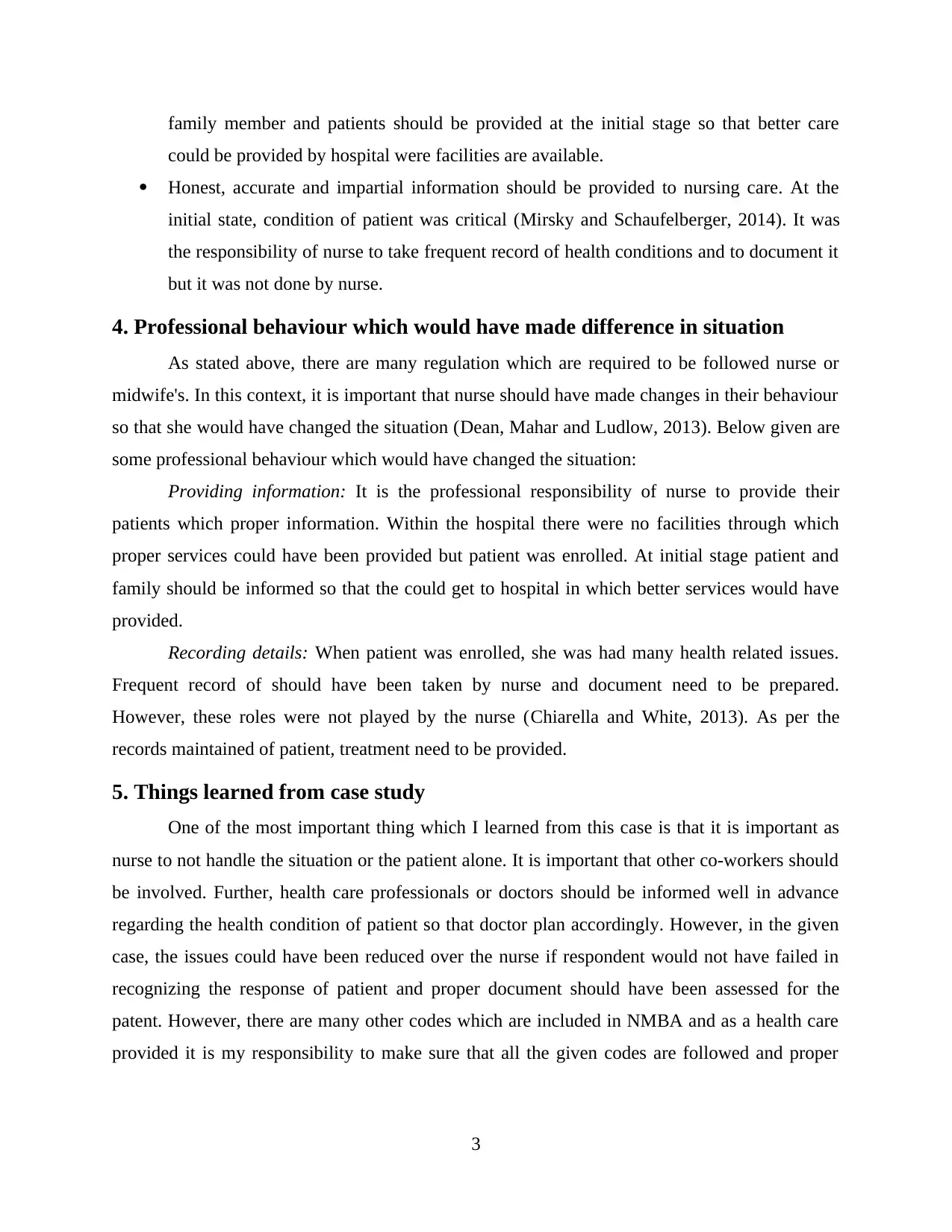
family member and patients should be provided at the initial stage so that better care
could be provided by hospital were facilities are available.
Honest, accurate and impartial information should be provided to nursing care. At the
initial state, condition of patient was critical (Mirsky and Schaufelberger, 2014). It was
the responsibility of nurse to take frequent record of health conditions and to document it
but it was not done by nurse.
4. Professional behaviour which would have made difference in situation
As stated above, there are many regulation which are required to be followed nurse or
midwife's. In this context, it is important that nurse should have made changes in their behaviour
so that she would have changed the situation (Dean, Mahar and Ludlow, 2013). Below given are
some professional behaviour which would have changed the situation:
Providing information: It is the professional responsibility of nurse to provide their
patients which proper information. Within the hospital there were no facilities through which
proper services could have been provided but patient was enrolled. At initial stage patient and
family should be informed so that the could get to hospital in which better services would have
provided.
Recording details: When patient was enrolled, she was had many health related issues.
Frequent record of should have been taken by nurse and document need to be prepared.
However, these roles were not played by the nurse (Chiarella and White, 2013). As per the
records maintained of patient, treatment need to be provided.
5. Things learned from case study
One of the most important thing which I learned from this case is that it is important as
nurse to not handle the situation or the patient alone. It is important that other co-workers should
be involved. Further, health care professionals or doctors should be informed well in advance
regarding the health condition of patient so that doctor plan accordingly. However, in the given
case, the issues could have been reduced over the nurse if respondent would not have failed in
recognizing the response of patient and proper document should have been assessed for the
patent. However, there are many other codes which are included in NMBA and as a health care
provided it is my responsibility to make sure that all the given codes are followed and proper
3
could be provided by hospital were facilities are available.
Honest, accurate and impartial information should be provided to nursing care. At the
initial state, condition of patient was critical (Mirsky and Schaufelberger, 2014). It was
the responsibility of nurse to take frequent record of health conditions and to document it
but it was not done by nurse.
4. Professional behaviour which would have made difference in situation
As stated above, there are many regulation which are required to be followed nurse or
midwife's. In this context, it is important that nurse should have made changes in their behaviour
so that she would have changed the situation (Dean, Mahar and Ludlow, 2013). Below given are
some professional behaviour which would have changed the situation:
Providing information: It is the professional responsibility of nurse to provide their
patients which proper information. Within the hospital there were no facilities through which
proper services could have been provided but patient was enrolled. At initial stage patient and
family should be informed so that the could get to hospital in which better services would have
provided.
Recording details: When patient was enrolled, she was had many health related issues.
Frequent record of should have been taken by nurse and document need to be prepared.
However, these roles were not played by the nurse (Chiarella and White, 2013). As per the
records maintained of patient, treatment need to be provided.
5. Things learned from case study
One of the most important thing which I learned from this case is that it is important as
nurse to not handle the situation or the patient alone. It is important that other co-workers should
be involved. Further, health care professionals or doctors should be informed well in advance
regarding the health condition of patient so that doctor plan accordingly. However, in the given
case, the issues could have been reduced over the nurse if respondent would not have failed in
recognizing the response of patient and proper document should have been assessed for the
patent. However, there are many other codes which are included in NMBA and as a health care
provided it is my responsibility to make sure that all the given codes are followed and proper
3
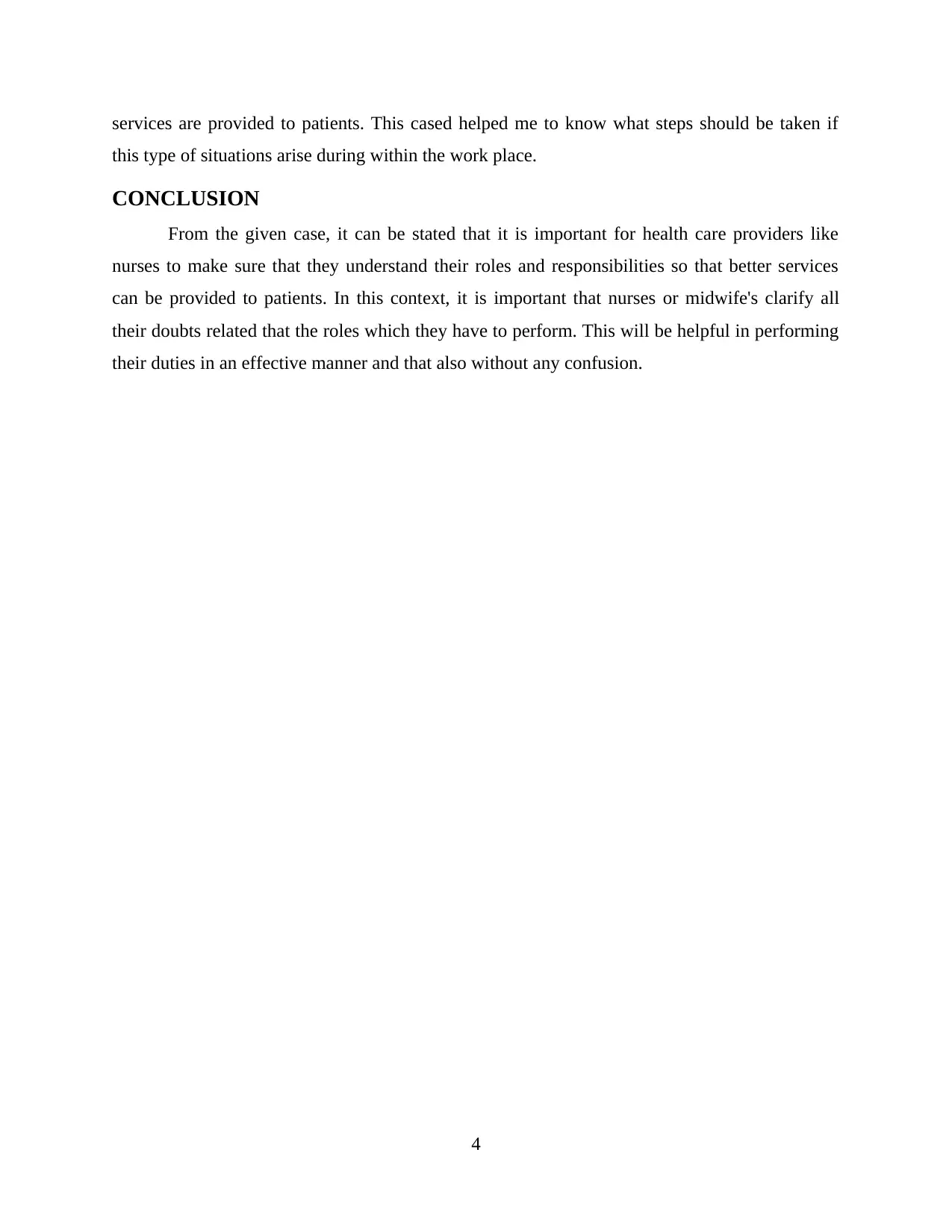
services are provided to patients. This cased helped me to know what steps should be taken if
this type of situations arise during within the work place.
CONCLUSION
From the given case, it can be stated that it is important for health care providers like
nurses to make sure that they understand their roles and responsibilities so that better services
can be provided to patients. In this context, it is important that nurses or midwife's clarify all
their doubts related that the roles which they have to perform. This will be helpful in performing
their duties in an effective manner and that also without any confusion.
4
this type of situations arise during within the work place.
CONCLUSION
From the given case, it can be stated that it is important for health care providers like
nurses to make sure that they understand their roles and responsibilities so that better services
can be provided to patients. In this context, it is important that nurses or midwife's clarify all
their doubts related that the roles which they have to perform. This will be helpful in performing
their duties in an effective manner and that also without any confusion.
4
⊘ This is a preview!⊘
Do you want full access?
Subscribe today to unlock all pages.

Trusted by 1+ million students worldwide
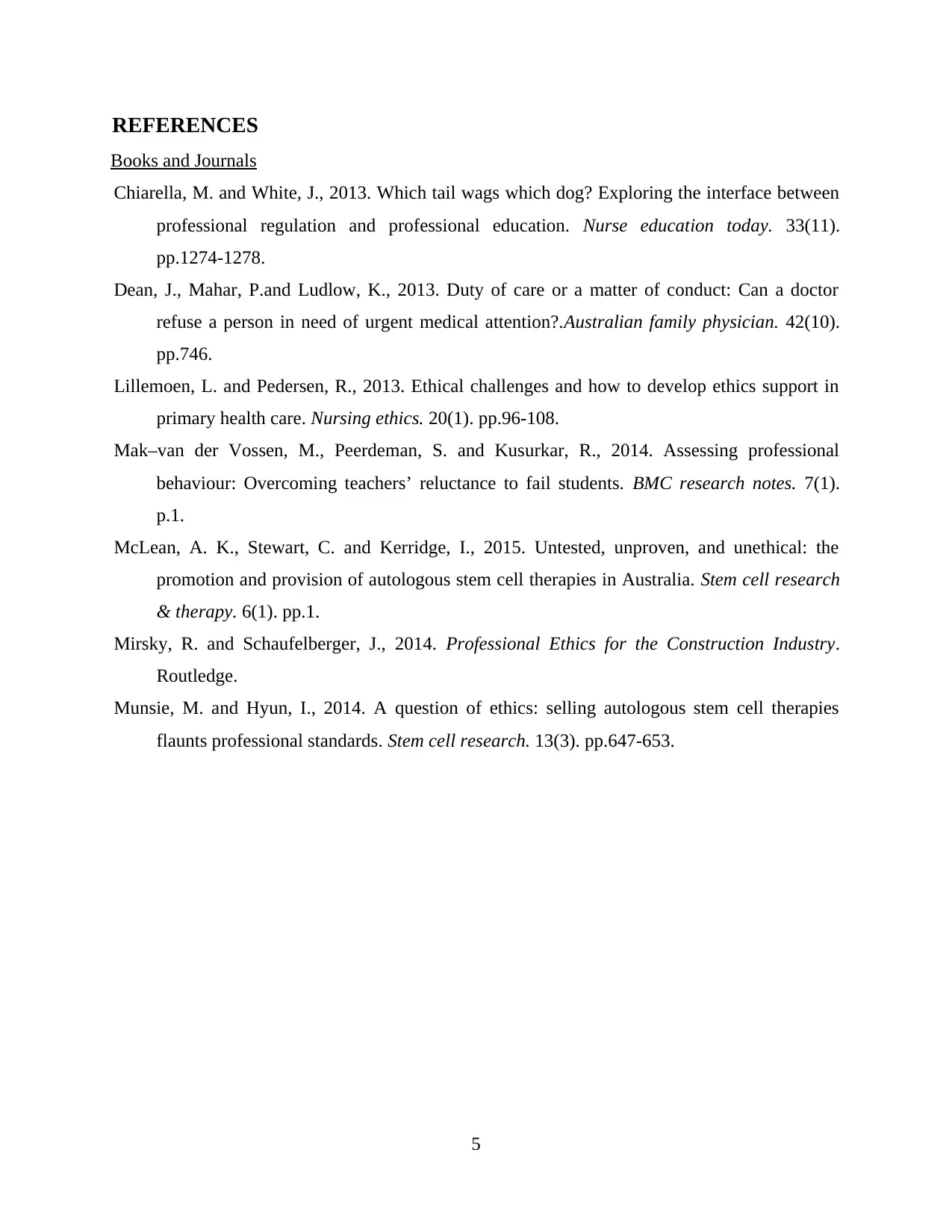
REFERENCES
Books and Journals
Chiarella, M. and White, J., 2013. Which tail wags which dog? Exploring the interface between
professional regulation and professional education. Nurse education today. 33(11).
pp.1274-1278.
Dean, J., Mahar, P.and Ludlow, K., 2013. Duty of care or a matter of conduct: Can a doctor
refuse a person in need of urgent medical attention?.Australian family physician. 42(10).
pp.746.
Lillemoen, L. and Pedersen, R., 2013. Ethical challenges and how to develop ethics support in
primary health care. Nursing ethics. 20(1). pp.96-108.
Mak–van der Vossen, M., Peerdeman, S. and Kusurkar, R., 2014. Assessing professional
behaviour: Overcoming teachers’ reluctance to fail students. BMC research notes. 7(1).
p.1.
McLean, A. K., Stewart, C. and Kerridge, I., 2015. Untested, unproven, and unethical: the
promotion and provision of autologous stem cell therapies in Australia. Stem cell research
& therapy. 6(1). pp.1.
Mirsky, R. and Schaufelberger, J., 2014. Professional Ethics for the Construction Industry.
Routledge.
Munsie, M. and Hyun, I., 2014. A question of ethics: selling autologous stem cell therapies
flaunts professional standards. Stem cell research. 13(3). pp.647-653.
5
Books and Journals
Chiarella, M. and White, J., 2013. Which tail wags which dog? Exploring the interface between
professional regulation and professional education. Nurse education today. 33(11).
pp.1274-1278.
Dean, J., Mahar, P.and Ludlow, K., 2013. Duty of care or a matter of conduct: Can a doctor
refuse a person in need of urgent medical attention?.Australian family physician. 42(10).
pp.746.
Lillemoen, L. and Pedersen, R., 2013. Ethical challenges and how to develop ethics support in
primary health care. Nursing ethics. 20(1). pp.96-108.
Mak–van der Vossen, M., Peerdeman, S. and Kusurkar, R., 2014. Assessing professional
behaviour: Overcoming teachers’ reluctance to fail students. BMC research notes. 7(1).
p.1.
McLean, A. K., Stewart, C. and Kerridge, I., 2015. Untested, unproven, and unethical: the
promotion and provision of autologous stem cell therapies in Australia. Stem cell research
& therapy. 6(1). pp.1.
Mirsky, R. and Schaufelberger, J., 2014. Professional Ethics for the Construction Industry.
Routledge.
Munsie, M. and Hyun, I., 2014. A question of ethics: selling autologous stem cell therapies
flaunts professional standards. Stem cell research. 13(3). pp.647-653.
5
1 out of 7
Related Documents
Your All-in-One AI-Powered Toolkit for Academic Success.
+13062052269
info@desklib.com
Available 24*7 on WhatsApp / Email
![[object Object]](/_next/static/media/star-bottom.7253800d.svg)
Unlock your academic potential
Copyright © 2020–2025 A2Z Services. All Rights Reserved. Developed and managed by ZUCOL.




